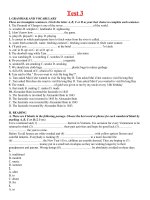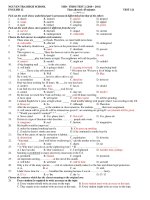Mid term test 3 on phonetics phonology (1)
Bạn đang xem bản rút gọn của tài liệu. Xem và tải ngay bản đầy đủ của tài liệu tại đây (87.86 KB, 5 trang )
HANOI OPEN UNIVERSITY
MID-TERM TEST ON PHONETICS & PHONOLOGY
E-LEARNING CENTRE
Test No: 3
BÀI GIẢI BÀI TỰ LUẬN
Question 1: What is a phoneme? How are phonemes classified? Give examples to illustrate your
answer.
Question 2: What is stress? What are the rules applied for affix-words? Give examples to illustrate your
answer.
N.B:* -The answers can be typed or written by hand, then changed into PDF form.
(HANDWRITING IS PLUS)
-Only answers in PDF form are accepted.
-The assignment which is copied or identical to others will be given mark 0.
Question 1: What is a phoneme? How are phonemes classified? Give examples to illustrate your answer.
A phoneme is the smallest distinctive unit of sound in a language that can change the meaning of a word. It is a
fundamental concept in phonology, which is the study of the sound patterns and structures of languages.
Phonemes are classified based on their distinctive features, which are the specific properties that differentiate one
phoneme from another. The two main types of distinctive features used for classifying phonemes are:
1. Articulatory Features: These features are related to how the sound is produced or articulated in the vocal tract.
a. Place of Articulation: The location in the vocal tract where the airflow is obstructed or constricted during the sound
production. Examples include bilabial (/p/, /b/), alveolar (/t/, /d/), and velar (/k/, /g/) sounds.
b. Manner of Articulation: The way in which the airflow is constricted or modified during sound production. Examples
include stops (/p/, /t/, /k/), fricatives (/f/, /s/, /ʃ/), and nasals (/m/, /n/, /ŋ/).
c. Voicing: Whether the vocal cords are vibrating during the sound production. Phonemes can be either voiced (/b/,
/d/, /g/) or voiceless (/p/, /t/, /k/).
2. Acoustic Features: These features are related to the physical properties of the sound wave produced during speech.
a. Duration: The length of time the sound is produced.
b. Frequency: The rate of vibrations of the sound wave, which determines the pitch of the sound.
c. Intensity: The amplitude or strength of the sound wave, which affects the volume of the sound.
Examples:
1. Place of Articulation:
- /p/ as in "pat" (bilabial voiceless stop)
- /t/ as in "top" (alveolar voiceless stop)
- /k/ as in "cat" (velar voiceless stop)
2. Manner of Articulation:
- /s/ as in "sit" (voiceless alveolar fricative)
- /m/ as in "mat" (bilabial nasal)
- /f/ as in "fun" (voiceless labiodental fricative)
3. Voicing:
- /b/ as in "bat" (voiced bilabial stop)
- /z/ as in "zip" (voiced alveolar fricative)
- /ʃ/ as in "she" (voiceless postalveolar fricative)
These examples demonstrate how phonemes are classified based on their articulatory and acoustic features. The
distinctiveness of phonemes allows languages to form unique words by using different combinations of these sounds.
Question 2: What is stress? What are the rules applied for affix-words? Give examples to illustrate your answer.
1. Stress in Language:
Stress refers to the emphasis or prominence given to a particular syllable or part of a word when it is spoken. In many
languages, including English, stress plays an important role in conveying meaning and distinguishing words or phrases.
The syllable or part of the word that receives greater emphasis is called the stressed syllable or stressed part.
In English, stress can change the meaning of words, especially when words are similar but differ only in stress patterns.
For example, "record" (noun, pronounced with stress on the first syllable) means a written account, while "record"
(verb, pronounced with stress on the second syllable) means to make a written account.
2. Rules for Stress in Affix-Words:
Affixes are morphemes that are attached to words to modify their meaning. In English, there are two types of affixes:
prefixes (attached to the beginning of a word) and suffixes (attached to the end of a word). When adding affixes to
words, the stress pattern may change following specific rules:
a. Prefixes:
In general, prefixes do not change the stress of the base word. The stress remains on the same syllable as in the base
word.
Example:
- The noun "present" (stress on the first syllable) becomes the verb "re-present" (stress still on the first syllable).
b. Suffixes:
The stress of a word may shift when adding certain suffixes. Some suffixes change the stress pattern based on the
syllable structure of the base word.
i. -ic, -sion, -tion, -al, -ity, -ity, -graphy, etc.:
When these suffixes are added to a base word, the stress often shifts to the syllable before the suffix.
Example:
- Base word: "ecoNOMy" (stress on the second syllable)
- With suffix: "ecoNOMic" (stress shifts to the third syllable)
ii. -ate, -ify, -ize, -ate, etc.:
When these suffixes are added to a base word, the stress often remains on the same syllable as in the base word.
Example:
- Base word: "comPLETE" (stress on the second syllable)
- With suffix: "comPLETEly" (stress remains on the second syllable)
iii. -er, -or, -ist, -ian, etc.:
When these suffixes are added to a base word, the stress often remains on the same syllable as in the base word.
Example:
- Base word: "sCIENTist" (stress on the second syllable)
- With suffix: "sCIENTific" (stress remains on the second syllable)
These examples illustrate how stress can change in words with affixes, depending on the type of affix and the syllable
structure of the base word. Understanding stress patterns is essential for accurate pronunciation and meaning
differentiation in English and many other languages.









